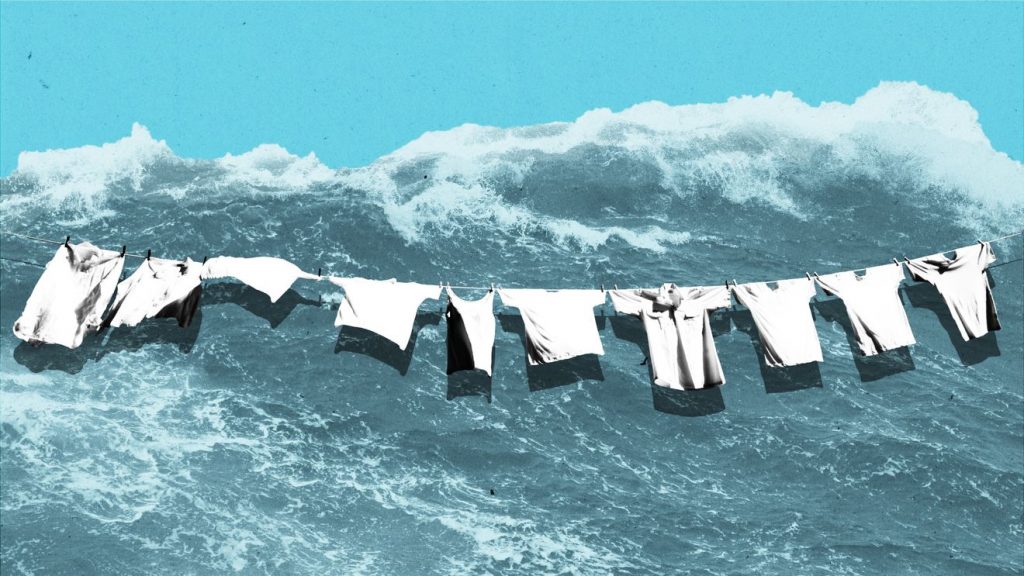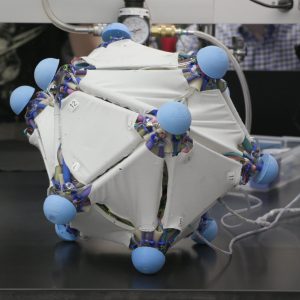Link About It: This Week’s Picks
The future of TV, Puerto Rico’s rebuild, a new Monopoly edition and more

Chinatown Soup’s Community-Minded Version of Monopoly
 NYC-based art and activism collective Chinatown Soup has developed a “Chinatown Edition” of Monopoly, but their version’s winner doesn’t play to control the city by achieving ownership of all valuable properties. Rather, players aim to create a more utopian neighborhood as the game “prizes the player that purposefully develops an area while keeping its residents in mind.” Highlighting the issues surrounding gentrification, this version of the game includes “Chance” cards like “Convert a tenement building into a condo, donate $200 to the Community Center for displacing the elderly,” and other socially responsible concepts. Find out more about this new iteration, and the original, at Artsy.
NYC-based art and activism collective Chinatown Soup has developed a “Chinatown Edition” of Monopoly, but their version’s winner doesn’t play to control the city by achieving ownership of all valuable properties. Rather, players aim to create a more utopian neighborhood as the game “prizes the player that purposefully develops an area while keeping its residents in mind.” Highlighting the issues surrounding gentrification, this version of the game includes “Chance” cards like “Convert a tenement building into a condo, donate $200 to the Community Center for displacing the elderly,” and other socially responsible concepts. Find out more about this new iteration, and the original, at Artsy.
Puerto Rico’s Rebuild Starts With Designers and Architects
 Since last September—immediately after Hurricane Maria—designers and architects have been working to not only rebuild Puerto Rico, but also to rethink its infrastructure. Many of the some 1,200 homes that lost roofing in the Caño Martin Pena area of Puerto Rico had “informal infrastructure”—in this instance meaning they were built with galvanized metal sheet roofs. Sadly, this is the case in large regions of Puerto Rico, and the devastating winds and flooding ruined much of what was just strong enough to fend off weaker rains. The efforts of the designers and architects have been concentrated on resiliency planning, implementing faster construction techniques, providing the island with renewable energy systems, developing housing types designed specifically for the island, assisting in the launching of new businesses and getting in the ear of policy-makers to provoke change. Read more about these efforts on Curbed.
Since last September—immediately after Hurricane Maria—designers and architects have been working to not only rebuild Puerto Rico, but also to rethink its infrastructure. Many of the some 1,200 homes that lost roofing in the Caño Martin Pena area of Puerto Rico had “informal infrastructure”—in this instance meaning they were built with galvanized metal sheet roofs. Sadly, this is the case in large regions of Puerto Rico, and the devastating winds and flooding ruined much of what was just strong enough to fend off weaker rains. The efforts of the designers and architects have been concentrated on resiliency planning, implementing faster construction techniques, providing the island with renewable energy systems, developing housing types designed specifically for the island, assisting in the launching of new businesses and getting in the ear of policy-makers to provoke change. Read more about these efforts on Curbed.
AR Puts Notable Women on US Bills
 Notable Women—a project from former Treasurer of the USA, Rosie Rios, along with Google Creative Lab and Nexus Studios—lets anyone with the power of AR and their smartphone’s camera put one of history’s most important women on the front of a bill. Once AR identifies the bill, it’ll place a portrait there and, by tapping said portrait, you’ll be able learn about that woman’s contributions to US history. The portraits fit seamlessly, thanks to acute attention to detail that makes these woman-adorned banknotes feel authentic. Read more about the project on It’s Nice That.
Notable Women—a project from former Treasurer of the USA, Rosie Rios, along with Google Creative Lab and Nexus Studios—lets anyone with the power of AR and their smartphone’s camera put one of history’s most important women on the front of a bill. Once AR identifies the bill, it’ll place a portrait there and, by tapping said portrait, you’ll be able learn about that woman’s contributions to US history. The portraits fit seamlessly, thanks to acute attention to detail that makes these woman-adorned banknotes feel authentic. Read more about the project on It’s Nice That.
The Truth About Plastic in Our Clothing
 Polyester, nylon, acrylic and other synthetic fibers—all plastic byproducts—make up 60% of the materials used in clothing. Even if wearers aren’t tossing their shirts or pants into the ocean when they’re done with them, the plastics in our clothing still make their way there. With each wash, fibers shed from the clothing and are drained through waterways into the ocean. “Think about how many people are washing their clothes on a daily basis, and how many clothes we all have,” says Imogen Napper, a marine scientist at the University of Plymouth. A study she co-authored found that individuals generate 793 pounds of shed plastic throughout the year. “A large proportion will get caught by the sewage treatment works, [but] even that small proportion that does fall through is going to accumulate,” she continues. Read more about the issue on Vox.
Polyester, nylon, acrylic and other synthetic fibers—all plastic byproducts—make up 60% of the materials used in clothing. Even if wearers aren’t tossing their shirts or pants into the ocean when they’re done with them, the plastics in our clothing still make their way there. With each wash, fibers shed from the clothing and are drained through waterways into the ocean. “Think about how many people are washing their clothes on a daily basis, and how many clothes we all have,” says Imogen Napper, a marine scientist at the University of Plymouth. A study she co-authored found that individuals generate 793 pounds of shed plastic throughout the year. “A large proportion will get caught by the sewage treatment works, [but] even that small proportion that does fall through is going to accumulate,” she continues. Read more about the issue on Vox.
Skin-Inspired Robotic Enhancements Animate the Inanimate
 Developed by Yale’s Rebecca Kramer-Bottiglio for NASA, new robotic skins aim to fit around static options and give them form—and movement. The skins are composed of supple elastic sheets and have sensors and actuators embedded throughout. This is a fascinating development that reflects a tangential robotics market, wherein an enhancement—rather than an independent form—is produced. Further, using more than one skin can lead to increasing complex series of movements. Anything, in theory, can become a moving robot. Read more at Interesting Engineering.
Developed by Yale’s Rebecca Kramer-Bottiglio for NASA, new robotic skins aim to fit around static options and give them form—and movement. The skins are composed of supple elastic sheets and have sensors and actuators embedded throughout. This is a fascinating development that reflects a tangential robotics market, wherein an enhancement—rather than an independent form—is produced. Further, using more than one skin can lead to increasing complex series of movements. Anything, in theory, can become a moving robot. Read more at Interesting Engineering.
Lyft Launches Open-Source Design Tool
 Most of the world’s largest companies protect their patents, data and design tools at all costs. But, as coding and design careers become increasingly coveted in today’s market, more people are interested in mastering (or at least brushing up on) the tools and techniques of the trade. A handful of larger companies have decided to go open-source with some of their internal tools, and Lyft is the most recent—launching Colorbox, an application that lets designers make accessible color systems. Read more about Colorbox’s launch on Product Hunt.
Most of the world’s largest companies protect their patents, data and design tools at all costs. But, as coding and design careers become increasingly coveted in today’s market, more people are interested in mastering (or at least brushing up on) the tools and techniques of the trade. A handful of larger companies have decided to go open-source with some of their internal tools, and Lyft is the most recent—launching Colorbox, an application that lets designers make accessible color systems. Read more about Colorbox’s launch on Product Hunt.
Replicating ’50s Design Inside a Care Center for Alzheimer’s Patients
 Featuring 11 storefronts replicating the design of the ’50s, Glenner Town Square in Chula Vista, California isn’t a film set—it’s a care center for dementia patients. From Rosie’s Diner to Alois’ Newsstand, each build-out aims to represent a portion of life during the prime years of patients—activating a type of a reminiscence therapy. Altogether, the goal is to initiate engagement and trigger conversation. The partners—non-profit George G. Glenner Alzheimer’s Family Centers and Senior Helpers, a national senior care provider—plan to franchise the idea. Read more at the Wall Street Journal.
Featuring 11 storefronts replicating the design of the ’50s, Glenner Town Square in Chula Vista, California isn’t a film set—it’s a care center for dementia patients. From Rosie’s Diner to Alois’ Newsstand, each build-out aims to represent a portion of life during the prime years of patients—activating a type of a reminiscence therapy. Altogether, the goal is to initiate engagement and trigger conversation. The partners—non-profit George G. Glenner Alzheimer’s Family Centers and Senior Helpers, a national senior care provider—plan to franchise the idea. Read more at the Wall Street Journal.
Amazon’s Echo Show Hints at the Future of TV
 Beyond a screen, microphone and speaker upgrade, Amazon’s new Echo Show (announced last week with a slew of other refined and amped-up products–a microwave included) opens up a new dialogue surrounding the future of TV hardware. It may look like a tablet head-on, but from streaming live TV content (NBC and Hulu) to its preference not to be touched (despite having a touchscreen, the microphones are its most powerful guide), it’s more like a countertop TV than Amazon’s actual TV sets. Read more on Wired about the shifting definition of TV and how Amazon’s slate fits into it all.
Beyond a screen, microphone and speaker upgrade, Amazon’s new Echo Show (announced last week with a slew of other refined and amped-up products–a microwave included) opens up a new dialogue surrounding the future of TV hardware. It may look like a tablet head-on, but from streaming live TV content (NBC and Hulu) to its preference not to be touched (despite having a touchscreen, the microphones are its most powerful guide), it’s more like a countertop TV than Amazon’s actual TV sets. Read more on Wired about the shifting definition of TV and how Amazon’s slate fits into it all.
Link About It is our filtered look at the web, shared daily in Link and on social media, and rounded up every Saturday morning.











